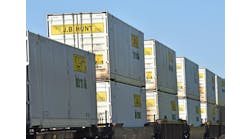Perhaps falling into the category of “no good deed being left unpunished,” the adoption of electronic logging devices (ELDs) by the trucking industry is now being cited as evidence that owner-operator truck drivers are really employees instead of independent contractors.
As of 2017, all commercial vehicles operating in interstate commerce were required to have ELDs for the purpose of enforcing federal hours-of-service regulations. Prior to that, many fleet operators had required their drivers use electronic on-board recorders (EOBRs) to monitor their drivers’ hours and other behavior on the road.
The goal of ELDs and EOBRs was to eliminate the widespread cheating by drivers when they used paper logs to record their hours, something which happened with such frequency that drivers took to calling the duplicate logs “comic books.” The ELD mandate has seen HOS violations virtually disappear, but also had the effect of reducing driver productivity—a tradeoff most shippers were willing to embrace.
At the same time, fleet operators gained access to a new technology that also could be used to help them monitor the fleet, comply with state and federal regulations, and understand a driver’s driving behavior.
And there’s the rub. In the changing world of employee classification law, many state legislatures and courts increasingly embrace the concept that determining whether a driver is an employee or independent contractor turns on how much control the fleet operator exerts over that person’s work. The more control, the less likely they are to be defined as an independent contractor.
That control could be established by looking at a number of factors, but in the end boils down to how much the contractor controls the manner and means of accomplishing the desired result. Can the drivers turn down assignments? Are they able to contract to other employers? To what degree does the company control the procedures and practices used by the drivers? These all are typical questions asked to establish control.
“New technology simply makes it easier for a driver to show trucking company control, even if the driver signed a document identifying him as an independent contractor,” point out Jeremy K. Schrag and Morgan L. Simpson, attorneys with law firm Lewis Brisbois Bisgaard & Smith.
Cases Prove the Point
Recently, the California Labor Commissioner ruled in favor of 24 truck port drivers who argued that they had been employees, not contractors, granting them a $6 million settlement. The commissioner decided that the trucking firm had not met its burden of proving the affirmative defense that the truck drivers were independent contractors.
The commissioner concluded that the drayage company retained pervasive control over the operation as a whole, and that the drivers’ services were an integral part of that business. The commissioner’s ruling rested primarily on the finding that the fleet company managed the truck drivers through a dispatch system that relied primarily on electronic communication. This system, the commissioner held, provided substantial evidence to support for the finding that the drivers “were functioning as employees rather than as true independent contractors.”
(Even more ominously, in this case the California commissioner also found the trucking company’s general manager was individually liable for misclassifying the drivers as independent contractors.)
In another case currently on appeal to the Ninth Circuit U.S. Court of Appeals, a district court had affirmed that truckload carrier Swift Transportation Co. misclassified multiple drivers as independent contractors. The district court noted the various ways the trucking firm monitored the drivers, including the use of a telematics communication system.
The court further added that the trucking firm had the “ability to know where all drivers are and what their availability is at frequent intervals.” The fact that the trucking firm rarely used its ability to monitor drivers did not seem to carry as much weight as did the fact that the trucking firm could monitor the drivers if it wished to do so.
The availability and use of sophisticated telematics packages may show, in the right (or wrong) set of circumstances, that the trucking fleet is exercising significant control over the owner-operator, observe Schrag and Simpson. “Although the test to determine whether a driver is an employee or independent contractor varies depending on the jurisdiction, nearly every court considers the degree of control the company exercises over the driver.
“Moving forward, it is important for trucking firms to understand the relationship between wage and hour litigation and the monitoring capability of telematics packages,” they add. “Trucking fleets that use sophisticated telematics tracking devices to monitor, assign and check in on independent owner-operator drivers are at a higher risk of an adverse wage and hour decision.”




